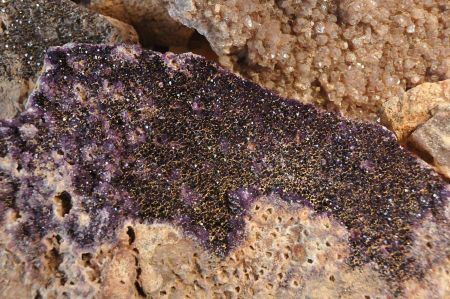An Amethyst Mine in the mountains of Dursunbey
- Written by Portal Editor
We were following the main road from Dursunbey to the right towards Beyel, continued to the fire station that brought us to about 800 meters above sea level in its park-like grounds, to the Dursunbey river and to the imposing canyons and on the way back to the local Amethyst Mine.
We found a large pile of rocks with the shimmer of crystal reflecting sunlight on its surface, visible from far. Next to a small wooden hut for shelter, we found two people, one of whom spoke to us directly in German. He was from Frankfurt, but now live in Ankara, where he runs a restaurant. The other, who runs the degradation of Amethyst, sat almost impassively deepened in his work at a table and cleaned the crystals in the rock during our conversation. What a destination for walkers or mountain bikers, our first thought was. Many visitors would certainly have great interest to push themselves as Amethyst Miner.
Amethyst is a relatively common quartz variety; large and clear specimens that are suitable for processing as a gemstone, limited to comparatively few localities. Deposits of amethyst are in Brazil, Uruguay, Namibia, Madagascar, Russia, Sri Lanka, Morocco and Turkey. Amethyst crystals are found primarily in cavities in hydrothermal veins and in volcanic rocks. Frequently commercially used species are the so-called Amethyst, in which the crystals have been formed within a cavity surrounded by a layer of Chalcedon. Most Druze originate usually from Brazil and can be as high as a man.
The origin of the name Amethyst comes from the Greek word amethystos - "intoxication antagonistic" - which expresses the old belief that a carrier of amethyst has the intoxicating effects of wine, meaning is immune against alcohol. The mythology says that you will not get drunken if you take the wine out of a cup of amethyst. Originally, this superstition is related with the custom to dilute wine with water, which then took on a reddish-purple (amethyst) staining. At the same time, of course, you can drink much more of it without being too drunk or even having to suffer a hangover.
Another variation of the naming is, that Bacchus, the god of wine, frightened a young girl so that it solidified into crystal. Then the God sighed so vigorously that his breath when it touched upon a stone, the stone colored purple like the color of the wine.
Hildegard von Bingen (1098-1179) described in her "Book of stones", among other things, the usage of Amethyst as a healing stone against diseases such as blemishes and swelling, but also effective against attacks by insects, spiders and snake bites.
In spiritual circles the Amethyst is also used as a healing stone in the gemstone therapy to support against alcoholism and other addictions. In addition, it cleansing, inspiring and knowledge-making properties are attributed by the impact on the brow chakra. The scientific evidence for such effects, however, does not exist so far, although periodic healing successes were recorded, but these are attributed to the placebo effect.
The Amethyst was also rumored to have an apostrophic effect against theft. This fact is evidenced by prehistoric grave finds. Merovingian Period graves with Amethyst show, if at all, spurs of theft could not be found in the field of laying the stones (necklace), even not when golden pendant were to be found there. Perhaps there was a further reputed effect of amethyst on the thief in this era from the early history already.
The purple color of amethyst ranges from a very light, slightly pink to very dark purple, under the influence of sunlight amethysts however lose color quite fast. The stones should therefore not be exposed to direct UV radiation.
Amethyst gemstone quality is a popular and widespread gemstone which to trade either in different faceted shapes (diamond, Navette, Briolett) or smooth cabochon which is sanded. Particularly valuable dark purple stones apply.
Burnt bricks usually get significantly more cracks and flaws that stand out for their luster. Often the crystal shows points and surfaces. Usually only the burned amethysts are lower in quality to make it as "upgrade". This is a processing by which the color is changed with methods that appear identical in nature, while not essential characteristics to be changed.
Other reports and blog articles to magnificent surroundings of Dursunbey will follow.
Please read as well:
Open air Stalactite formations at Dursunbey Cayi
Exploration trip to Dursunbey - unspoiled nature awaiting us
-
-
-
-
-
-
-
-
-
-
-
-
-
-
-
https://www.alaturka.info/en/turkey-country/marmara-region/3300-an-amethyst-mine-in-the-mountains-of-dursunbey/amp#sigProIda046ddff7a
